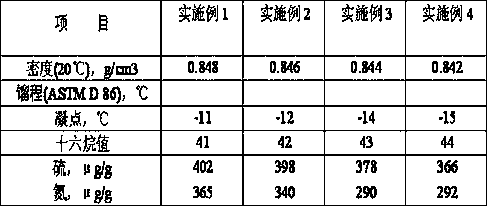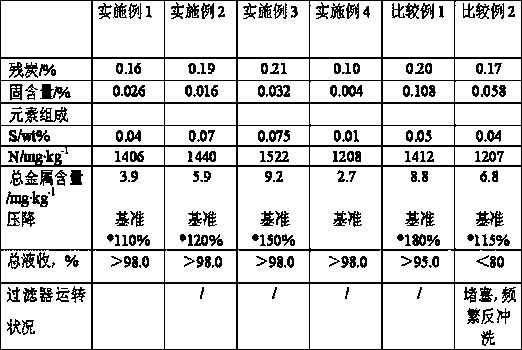Coal tar and residual oil combined treatment process
A treatment process, coal tar technology, applied in hydroprocessing process, petroleum industry, hydrocarbon oil treatment, etc., can solve problems such as low liquid yield, easy blockage of filter, incomplete removal of catalyst powder, etc.
- Summary
- Abstract
- Description
- Claims
- Application Information
AI Technical Summary
Problems solved by technology
Method used
Image
Examples
Embodiment 1
[0052] Embodiment 1 uses residual oil and coal tar whole distillate as raw materials, adopts coal tar and residual oil combined treatment process of the present invention, and residual oil and coal tar heavy fraction enters the first hydroprocessing unit (the first hydroprocessing unit adopts fixed bed Reactor), hydrogenation reaction is carried out in the presence of hydrogen and the first hydrotreating catalyst; the liquid phase effluent obtained after the reaction directly enters the catalytic cracking unit without fractionation, and the reaction product is separated to obtain dry gas, liquefied gas, catalytic Gasoline, catalytic diesel, catalytic heavy cycle oil and catalytic oil slurry; the catalytic oil slurry is firstly mixed with the first additive coal tar distillate oil, the ratio of catalytic oil slurry to the first additive is 19:1, and the catalytic oil slurry and the second additive The mixing treatment temperature and mixing treatment time of the first auxiliary ...
Embodiment 2
[0054] Embodiment 2 uses residual oil and coal tar whole distillate as raw materials, adopts coal tar and residual oil combined treatment process of the present invention, and residual oil and coal tar heavy fraction enters the first hydroprocessing unit (the first hydroprocessing unit adopts fixed bed Reactor), hydrogenation reaction is carried out in the presence of hydrogen and the first hydrotreating catalyst; the liquid phase effluent obtained after the reaction directly enters the catalytic cracking unit without fractionation, and the reaction product is separated to obtain dry gas, liquefied gas, catalytic Gasoline, catalytic diesel, catalytic heavy cycle oil and catalytic oil slurry; catalytic oil slurry is first mixed with the first additive coal tar distillate and the second additive decahydronaphthalene, and the catalytic oil slurry is mixed with the first additive and the second additive The ratios are 20:1 and 70:1 respectively, the mixing treatment temperature and...
Embodiment 3
[0056] Embodiment 3 uses residual oil and coal tar whole distillate as raw materials, adopts coal tar and residual oil combined treatment process of the present invention, and residual oil and coal tar heavy fraction enters the first hydroprocessing unit (the first hydroprocessing unit adopts fixed bed Reactor), hydrogenation reaction is carried out in the presence of hydrogen and the first hydrotreating catalyst; the liquid phase effluent obtained after the reaction directly enters the catalytic cracking unit without fractionation, and the reaction product is separated to obtain dry gas, liquefied gas, catalytic Gasoline, catalytic diesel oil, catalytic heavy cycle oil and catalytic oil slurry; the catalytic oil slurry is mixed with the first additive coal tar distillate oil, the ratio of catalytic oil slurry to the first additive is 21:1, and the catalytic oil slurry and the second additive The mixing treatment temperature and mixing treatment time of the first auxiliary agen...
PUM
 Login to View More
Login to View More Abstract
Description
Claims
Application Information
 Login to View More
Login to View More - R&D
- Intellectual Property
- Life Sciences
- Materials
- Tech Scout
- Unparalleled Data Quality
- Higher Quality Content
- 60% Fewer Hallucinations
Browse by: Latest US Patents, China's latest patents, Technical Efficacy Thesaurus, Application Domain, Technology Topic, Popular Technical Reports.
© 2025 PatSnap. All rights reserved.Legal|Privacy policy|Modern Slavery Act Transparency Statement|Sitemap|About US| Contact US: help@patsnap.com



